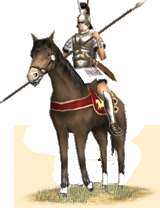Hippeis Thessalikoi (Thessalian Heavy Cavalry)
 |
Weapons | Defence | Mental | ||||||
|---|---|---|---|---|---|---|---|---|---|
| Primary | Secondary | Armour: | 13 | Morale: | 16 | ||||
| Type: | spear | sword | Shield: | 0 | Discipline: | disciplined | |||
| Attack: | 5 | 11 | Skill: | 11 | Training: | highly_trained | |||
| Charge: | 34 | 15 | Recruitment | Other | |||||
| Lethality: | 0.38 | 0.11 | Soldiers: | 25 | Hit Points: | 1 | |||
| Range: | 0 | 0 | Cost: | 4021 | Mass: | 1 | |||
| Ammo: | 0 | 0 | Upkeep: | 1005 | |||||
| Turns: | 1 | ||||||||

Hippeis Thessalikoi are drawn from the nobility of Thessaly. They are an extremely valuable heavy cavalry well capable of holding themselves in a melee after the charge has been completed.
Elite
Disciplined
Hardy
Thessalikoi heavy cavalry are drawn from the nobility of Thessalia, a region thoroughly under Makedonian control. They are extremely valuable heavy cavalry, well able to crush enemy resistance with a single thunderous charge. While not quite as powerful as the Hetairoi of Makedonia itself, the Thessalikoi are well able to give a good account of themselves in battle. Their lances and blades, combined with their shields, make them well able to hold in a melee after the charge has been completed and they have a degree of discipline that is enviable among cavalry warriors.
Historically, Thessalia was famous for its heavy cavalry. Unlike southern Hellene regions, the Thessalikoi had a wide expanse of plains and were able to breed horses extensively. They were able to keep the other Hellenes at bay even though they were poorer and less populous than their southern neighbors. They were joined with Makedonia during the reign of Phillipos, and provided cavalry to fuel Alexandros’ conquests. After Alexandros, they continued to provide heavy cavalry to the Makedonians until the Rhomaios invasion of 146 BC that destroyed much of Thessalia’s infrastructure. There is evidence that by this time heavy cavalry was employed only in smaller numbers, due to cost.